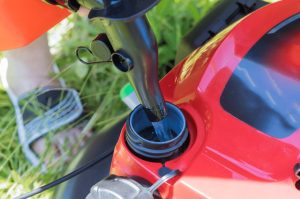In the vibrant tapestry of Australia’s natural landscape, red flowering trees are captivating highlights, painting our gardens and wild spaces with strokes of brilliant crimson. These trees, ranging from the modestly sized to the majestically tall, not only add a splash of colour but also bring many benefits to our environment. In this exploration, we’ll delve into the diverse world of Australia’s red flowering trees.
Each species tells a unique story, from the charming Crimson Bottlebrush to the imposing Illawarra Flame Tree. We’ll uncover how these trees contribute to local ecosystems and enhance landscaping designs, offering aesthetic pleasure and ecological value!
Red flowering tree identification
Identifying red flowering trees in Australia’s diverse landscapes hinges on observing a few key characteristics: leaf shape, flower attributes, and bark texture. Each element plays a crucial role in distinguishing one species from another.
- Leaf shape: Often the first noticeable feature, the leaves of red flowering trees vary widely. For instance, the Crimson Bottlebrush flaunts narrow, lance-shaped leaves, while the Illawarra Flame Tree displays broad, lobed leaves. Observing the size, shape, and arrangement of leaves can provide significant clues to the tree’s identity.
- Flower characteristics: The most striking feature of the flowers is not just their vivid red hues. Their size, shape, and arrangement on the tree are vital for identification. The Bottlebrush’s flowers, true to their name, resemble a brush with cylindrical, spiky blooms. In contrast, the Red Flowering Gum showcases large, fluffy blossoms clustered at the branch tips.
- Bark texture: Bark often gets overlooked but is a key identifier. The River Red Gum, for example, has a smooth, white to grey bark, peeling in long ribbons, while the Red Ironbark presents a hard, deeply furrowed bark, dark grey to black in colour. The bark’s texture, colour, and pattern can be distinctive markers for each species.
By paying attention to these details, one can learn to recognize and appreciate the unique beauty and diversity of Australia’s red flowering trees.
Benefits of red flowering trees
Red flowering trees, a spectacular feature of Australia’s flora, offer many benefits beyond their visual appeal.
Ecological benefits
- Attracting wildlife: These trees are a haven for biodiversity. The vibrant flowers of species like the Crimson Bottlebrush and Red Flowering Gum are rich in nectar, attracting various birds, bees, and butterflies. This interaction plays a crucial role in pollination and maintaining healthy ecosystems.
- Providing shade: Large red flowering trees, such as the River Red Gum, offer substantial shade. This creates cooler microclimates and helps in soil moisture retention, benefiting surrounding plant life.
- Enhancing biodiversity: We increase plant diversity by introducing red flowering trees into landscapes. This, in turn, supports a wider range of fauna, contributing to a more robust and resilient ecosystem.
Aesthetic and psychological benefits
- Visual appeal: The striking red blooms add a unique aesthetic quality to landscapes, making them more visually appealing and vibrant. This enhances the beauty of both natural and urban areas.
- Mental well-being: Studies have shown that exposure to natural beauty, including colourful trees, can significantly improve mental health. The presence of these trees in our surroundings can reduce stress, promote relaxation, and enhance overall well-being.
- Cultural significance: Many red flowering trees hold cultural importance and are often featured in art, literature, and community spaces, strengthening the cultural fabric and identity of local communities.
In essence, red flowering trees are not just a feast for the eyes but vital contributors to ecological health, mental well-being, and cultural richness.
Top trees with red flowers in Australia
Australia’s landscapes are graced with red flowering trees, each offering unique beauty and ecological value. Among the most notable, these are our favourite red flowering trees in Australia at Yard Work:
- Crimson Bottlebrush (Callistemon citrinus)
- New Zealand Tea Tree/Manuka (Leptospermum scoparium)
- Red Flowering Gum (Eucalyptus ficifolia)
- Scarlet Honeymyrtle (Melaleuca nesophila)
- River Red Gum (Eucalyptus camaldulensis)
- Queensland Tree Waratah (Alloxylon flammeum)
- Red Ironbark (Eucalyptus sideroxylon)
- Illawarra Flame Tree (Brachychiton acerifolius)
Each of these trees enhances the aesthetic appeal of our surroundings and plays a crucial role in supporting local ecosystems. Let’s delve deeper into the characteristics that make each of these trees a cherished part of Australia’s botanical heritage.
Small trees with red flowers
1. Crimson Bottlebrush (Callistemon citrinus)
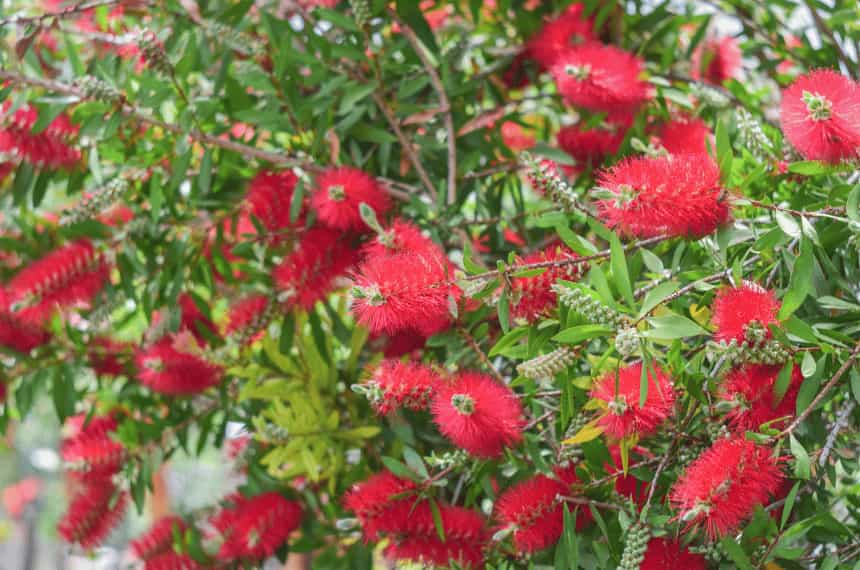
The Crimson Bottlebrush, scientifically known as Callistemon citrinus, is a small yet striking tree native to Australia. It’s celebrated for its unique, vibrant red brush-like flowers that bloom predominantly in spring and summer, attracting a symphony of birds and insects to the garden.
- Botanical characteristics: This tree typically grows to a modest height of 3 to 4 metres, making it an ideal choice for smaller gardens. Its leaves are lance-shaped, dark green, and emit a lemony scent when crushed, adding a sensory experience to its visual appeal.
- Ideal growing conditions: Callistemon citrinus thrives in full sun and well-drained soil. It’s remarkably adaptable, tolerating drought and occasional flooding, making it suitable for various Australian climates. Regular pruning after flowering can encourage denser growth and more vibrant blooms.
- Common uses in Australian gardens: Often used as a feature tree due to its eye-catching flowers, it’s also popular as a hedge or screening plant. Its compact size and resilience make it popular in urban gardens, coastal areas, and container gardening.
- Best suited gardens: Gardens that benefit most from the Crimson Bottlebrush are those looking for a low-maintenance yet visually stunning plant. It’s particularly well-suited for wildlife gardens, as it attracts nectar-feeding birds and beneficial insects, contributing to local biodiversity. Its adaptability also makes it a prime choice for coastal gardens and urban spaces where conditions can be challenging for more sensitive species.
2. New Zealand Tea Tree/Manuka (Leptospermum scoparium)
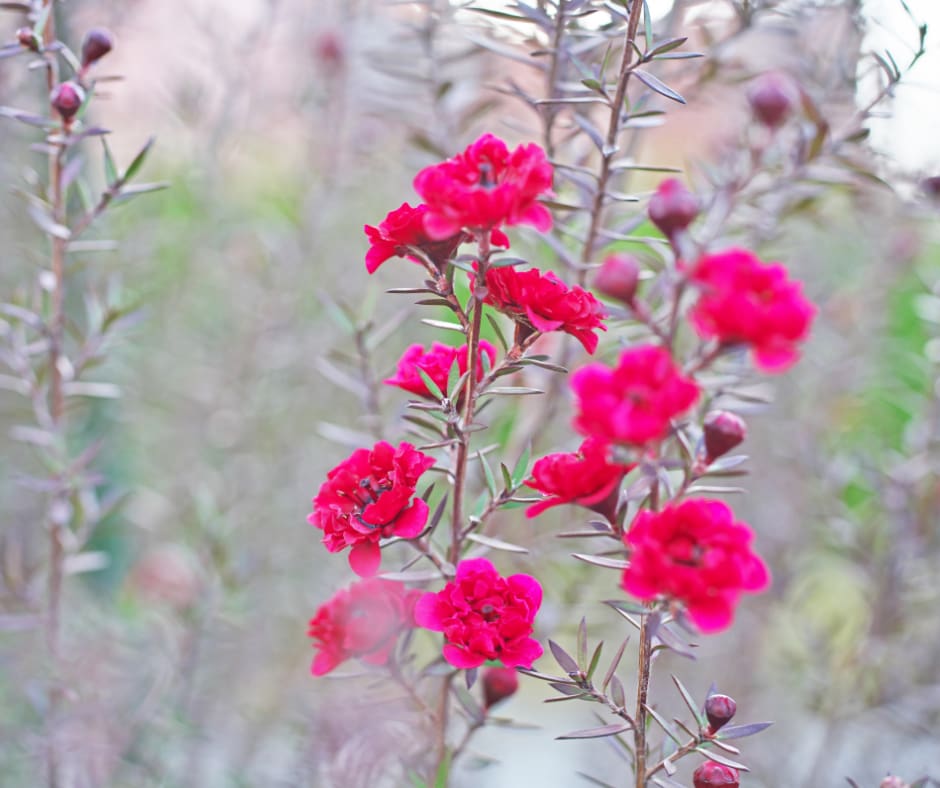
The New Zealand Tea Tree, or Manuka (Leptospermum scoparium), is a small tree or shrub renowned for its resilience and enchanting beauty. Originating from New Zealand and parts of Australia, it has become a beloved addition to many Australian gardens.
- Botanical characteristics: Manuka typically reaches 2 to 5 metres, making it an excellent choice for smaller garden spaces. It features dense, small, needle-like leaves and is celebrated for its profusion of small, red or pink flowers that bloom in spring and early summer. These flowers are visually appealing and famous for producing Manuka honey when pollinated by bees.
- Ideal growing conditions: Leptospermum scoparium prefers well-drained soil and can thrive in various soil types, from acidic to slightly alkaline. It’s best suited to full sun but can tolerate partial shade. This tree is notably hardy, capable of withstanding drought once established, and frost tolerant.
- Common uses in Australian gardens: Its compact size and attractive flowers make the Manuka a popular choice for ornamental purposes, whether as a standalone feature or part of a mixed border. It’s also used for screening and hedging, and its tolerance to pruning allows it to be shaped as desired.
- Best suited gardens: This tree is particularly well-suited for coastal gardens due to its salt tolerance. It’s also ideal for urban gardens where space might be limited, and its hardiness makes it a fit for low-maintenance landscapes. Gardens that aim to attract wildlife, especially bees, will find the Manuka an invaluable addition, contributing to the garden’s beauty and ecological health.
3. Red Flowering Gum (Eucalyptus ficifolia)
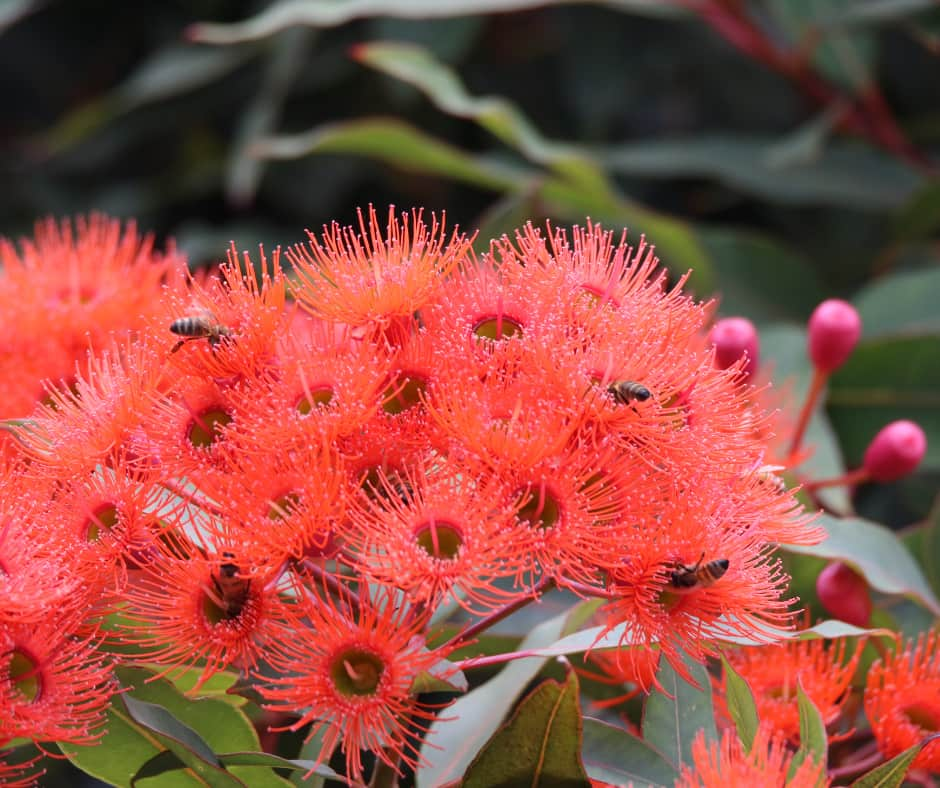
The Red Flowering Gum, known scientifically as Eucalyptus ficifolia, is a stunning small tree standout in any Australian garden due to its spectacular floral display.
- Botanical characteristics: This tree is renowned for its large, bright red flowers that bloom abundantly in the summer, creating a vivid splash of colour. It typically grows to a height of 4 to 8 metres, making it a manageable size for most garden spaces. The leaves are dark green, broad, and leathery, adding to its lush appearance year-round.
- Ideal growing conditions: Eucalyptus ficifolia thrives in well-drained soils and prefers a position in full sun. It is relatively drought-tolerant once established but benefits from occasional deep watering during extended dry periods. This species is also known for its adaptability to different soil types, including sandy and clay soils.
- Common uses in Australian gardens: Due to its moderate size and spectacular flowering, the Red Flowering Gum is often used as a feature tree in residential and public landscapes. It’s also popular for attracting wildlife, especially birds and bees, making it a great choice for nature-friendly gardens.
- Best suited gardens: This tree is particularly well-suited for gardens designed to be low maintenance yet visually striking. It’s an excellent choice for urban gardens where space might be limited but where a dramatic visual impact is desired. The Red Flowering Gum is also ideal for coastal gardens, as it can tolerate salty winds and sandy soils. Its ability to attract wildlife makes it a perfect fit for gardens aiming to support local biodiversity and create a natural haven for birds and insects.
4. Scarlet Honeymyrtle (Melaleuca nesophila)
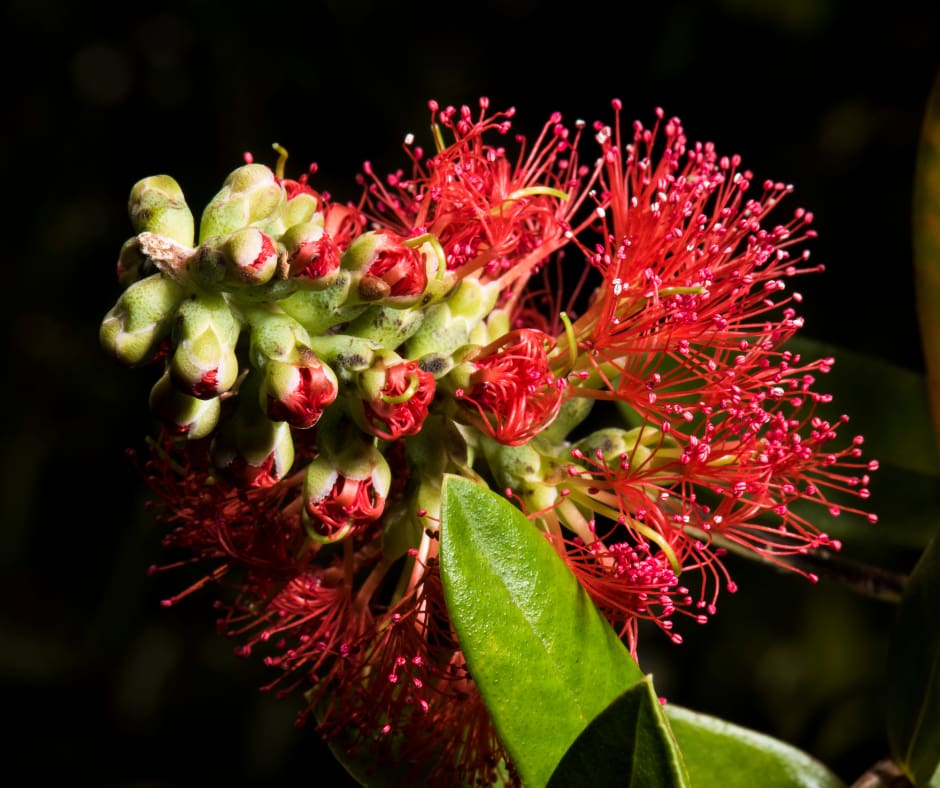
The Scarlet Honeymyrtle, scientifically known as Melaleuca nesophila, is a captivating small tree that uniquely charms Australian gardens with its vibrant floral displays.
- Botanical characteristics: This tree is distinguished by its dense, rounded canopy and striking scarlet flowers that bloom profusely, creating a spectacular display. The flowers, which appear mainly in spring and summer, are complemented by their dark green, oval-shaped leaves. Typically, Melaleuca nesophila reaches a height of 3 to 5 metres, making it an ideal size for smaller garden spaces.
- Ideal growing conditions: The Scarlet Honeymyrtle flourishes in well-drained soils and prefers full sun exposure for its best flowering. It is highly adaptable and can tolerate a range of soil types, including sandy and clay soils. This species is also known for its drought tolerance, making it suitable for water-wise gardens.
- Common uses in Australian gardens: Often used as a feature or specimen tree due to its stunning floral display, it’s also popular in native and wildlife gardens for attracting birds and bees. Its compact size makes it suitable for smaller gardens, and it can also be used in larger landscapes as part of a mixed shrub border.
- Best suited gardens: Gardens that benefit most from the Scarlet Honeymyrtle seek to create a vibrant visual impact with minimal maintenance. It’s particularly well-suited for coastal gardens, as it can withstand salty sea breezes. Urban gardens, where space might be at a premium, will find this tree a perfect fit due to its moderate size and ornamental value. Additionally, gardens designed to attract and support local wildlife will find the Scarlet Honeymyrtle an invaluable addition, thanks to its nectar-rich flowers.
Big trees with red flowers
5. River Red Gum (Eucalyptus camaldulensis)

The River Red Gum, Eucalyptus camaldulensis, is a majestic and iconic Australian tree, known for its imposing stature and ecological significance.
- Size and growth: This towering tree can reach impressive heights, often up to 35 metres. Its robust trunk and expansive canopy make it a dominant feature in any landscape. The River Red Gum grows relatively quickly, making it a prominent and long-lasting addition to large spaces.
- Flowering habits: The River Red Gum blooms with clusters of creamy-white flowers, which, despite not being red, are rich in nectar and attract various wildlife. These flowers typically appear in late spring and summer, providing a vital food source for native birds and insects.
- Versatile landscape applications: The River Red Gum is a versatile giant, ideal for stabilising riverbanks in riparian areas, providing expansive shade in large gardens and parks, serving as a windbreak in rural landscapes, and enhancing biodiversity in spacious urban green spaces. Its adaptability across various settings makes it valuable in natural and urban environments.
The River Red Gum’s grandeur and ecological benefits make it a cherished and vital component of the Australian landscape, both in natural and designed environments.
6. Queensland Tree Waratah (Alloxylon flammeum)
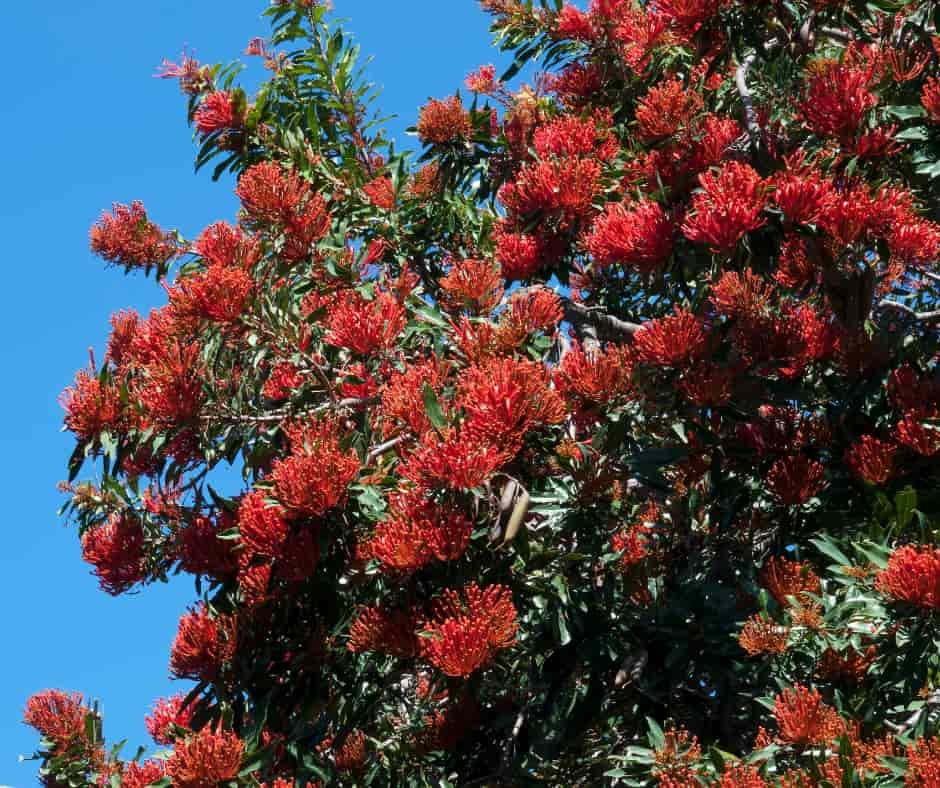
The Queensland Tree Waratah, known scientifically as Alloxylon flammeum, is a magnificent large tree native to Australia, celebrated for its striking appearance and vibrant flowers.
- Size and growth: This tree typically reaches 10 to 20 metres, making it a prominent feature in any landscape. It has a relatively upright growth habit, with a well-branched structure that forms a rounded canopy.
- Flowering habits: The Queensland Tree Waratah is renowned for its large, bright red flowers that appear in spring and early summer. These flowers are visually stunning and attract a variety of birds, particularly nectar-feeding species, contributing to local biodiversity.
- Broad landscape adaptability: The Queensland Tree Waratah excels in subtropical climates, making it a standout choice for public parks, large gardens, and wildlife-friendly spaces in warmer regions. Its stunning red flowers and lush foliage render it an ideal feature tree, enhancing the aesthetic and ecological value of both private and public landscapes.
The Queensland Tree Waratah’s combination of beauty, size, and ecological value makes it a prized choice for various Australian landscapes, from private gardens to public spaces.
7. Red Ironbark (Eucalyptus sideroxylon)

The Red Ironbark, or Eucalyptus sideroxylon, is a robust and visually striking tree, well-known for its distinctive bark and floral beauty.
- Size and growth: This imposing tree can reach 20 to 35 metres, characterised by a strong, dense canopy. The Red Ironbark’s most notable feature is its deeply furrowed, dark reddish-brown bark, which is visually striking and functionally protective.
- Flowering habits: It produces small, white to pink flowers, which, despite their subtle colour, are abundant and rich in nectar. These flowers typically bloom from late winter to spring, attracting several birds and insects, and play a significant role in the local ecosystem.
- Versatile and hardy landscape setting: The Red Ironbark is ideal for urban street planting due to its resilience and practical choice for rural windbreaks and erosion control. Its nectar-rich flowers benefit wildlife gardens, and its striking appearance makes it a splendid ornamental tree for larger landscapes.
The Red Ironbark’s resilience, ecological benefits, and aesthetic qualities make it a versatile and valuable addition to a wide range of Australian landscapes.
8. Illawarra Flame Tree (Brachychiton acerifolius)

The Illawarra Flame Tree, known scientifically as Brachychiton acerifolius, is a spectacular and iconic Australian tree celebrated for its brilliant red flowers.
- Size and growth: This large tree can reach up to 20 metres in height, featuring a broad and spreading canopy. Its striking appearance is particularly noteworthy, with a smooth grey bark and large, lobed leaves.
- Flowering habits: The Illawarra Flame Tree is renowned for its vivid red, bell-shaped flowers that bloom profusely, usually in late spring or early summer. Interestingly, the tree often loses its leaves before flowering, making the red blooms stand out dramatically against the bare branches.
- Dramatic and ecologically valuable: The Illawarra Flame Tree excels as a stunning feature in large gardens and public spaces. It thrives in coastal conditions, and supports local wildlife with its nectar-rich flowers, making it a versatile and striking choice for diverse Australian landscapes.
The Illawarra Flame Tree’s combination of dramatic beauty, size, and ecological benefits makes it a prized choice for various Australian landscapes, enhancing its aesthetic and biodiversity.
Challenges in conserving native red flowering trees in Australia
Conserving native red flowering trees in Australia presents a unique set of challenges crucial for maintaining the country’s rich botanical heritage and ecological balance.
- Habitat loss: Urbanisation and land clearing for agriculture are leading causes of habitat loss for these native species. As their natural habitats shrink, so do the populations of these trees, along with the wildlife that depends on them.
- Climate change: Changing climate patterns pose a significant threat. Altered rainfall patterns, increased temperatures, and the frequency of extreme weather events can adversely affect the growth and survival of these trees.
- Pests and diseases: Native trees are increasingly vulnerable to pests and diseases, some exacerbated by climate change and human activity. These threats can lead to declining tree health and, in severe cases, tree death.
- Invasive species: The introduction of invasive plant species competes with native red flowering trees for resources such as light, water, and nutrients. This competition can be detrimental to the growth and proliferation of native species.
Addressing these challenges requires a concerted effort involving habitat protection, climate change mitigation, pest and disease management, controlling invasive species, and public education. By tackling these issues, we can help ensure that these magnificent trees continue to thrive in Australia’s landscapes.
Care and maintenance for red flowering trees
Caring for red flowering trees in Australia involves a few key practices to ensure their health and longevity.
Here’s some quick practical advice on general care:
- Mulching helps retain soil moisture and suppress weeds. Use organic mulch, keeping it away from the tree trunk to prevent rot.
- Fertilising can be beneficial, especially for younger trees. Use a slow-release fertiliser that’s appropriate for the specific species.
- Protect young trees from harsh conditions, such as strong winds or frost, until they are well established.
Below, we’ll expand more into the watering, pruning, soil requirements and pests to watch out for when caring for your red flowering Australian trees.
Watering
- Young trees require regular watering to establish their root systems. Once established, many native red flowering trees are drought-tolerant but benefit from occasional deep watering during extended dry periods.
- Over-watering can be detrimental, especially for species adapted to dry conditions. It’s important to allow the soil to dry out between watering.
Pruning
- Pruning is essential for removing dead or diseased branches and encouraging healthy growth and flowering.
- The best time to prune is typically after the flowering season, as pruning beforehand can reduce the number of blooms.
- Light pruning can promote bushier growth and more flowers for species like the Crimson Bottlebrush.
Soil requirements
- Most red flowering trees prefer well-drained soil. Poor drainage can lead to root rot and other issues.
- While these trees can often adapt to a range of soil types, some may require specific soil pH levels. It’s beneficial to test the soil and amend it if necessary.
Pest control
- Regularly inspect trees for signs of pests or diseases. Common issues include borers, scale insects, and fungal diseases.
- Use eco-friendly pest control methods, such as encouraging beneficial insects or organic sprays.
By following these care guidelines, gardeners can help ensure that their red flowering trees remain vibrant and healthy, contributing to Australian gardens’ beauty and ecological diversity.
Garden design ideas with red flowering trees
Incorporating red flowering trees into landscape design can transform an ordinary space into a vibrant and dynamic garden.
Here are some ideas and tips on how to effectively use these trees, considering their size, colour contrast, and seasonal changes:
- Creating focal points: Use trees like the Illawarra Flame Tree or Red Flowering Gum in your garden. Their bright red flowers create eye-catching spots that draw attention. Position these trees where they can be easily seen from key viewing points, such as near a patio, window, or at the end of a pathway.
- Size considerations: Choose compact varieties like the Crimson Bottlebrush or Scarlet Honeymyrtle for smaller gardens. These can add colour without overwhelming the space. In larger landscapes, taller trees like the River Red Gum can be used to create shade and structure.
- Colour contrast and combinations: Pair red flowering trees with contrasting colours, such as silver-foliage plants or those with purple, blue, or white flowers, to create a visually striking contrast. Consider the overall colour scheme of your garden and choose tree varieties that complement or enhance these colours.
- Seasonal changes: Plan for seasonal interest. Many red flowering trees appear differently throughout the year, from lush foliage to vibrant blooms to interesting bark textures. We recommend combining trees that flower at different times to ensure year-round colour and interest in the garden.
- Layering and texture: Use these trees as part of a layered landscape design. Combine them with shrubs, perennials, and groundcovers to create a rich tapestry of textures and forms. Consider the tree’s foliage and bark texture when planning its placement. This can add to the garden’s visual interest even when the tree is not blooming.
By thoughtfully integrating red flowering trees into your landscape design, you can create a garden that is aesthetically pleasing, ecologically beneficial, and enjoyable throughout the seasons.
Final thoughts
In conclusion, red flowering trees are a cornerstone of Australian landscapes, offering a blend of stunning beauty and ecological benefits. From the compact Crimson Bottlebrush to the towering Illawarra Flame Tree, these species enrich our gardens with vibrant colours, attract diverse wildlife, and adapt to various environmental conditions. Their versatility in landscape design, from creating focal points to enhancing biodiversity, underscores their value.
Embracing these native treasures elevates the aesthetic appeal of our surroundings. It plays a vital role in preserving Australia’s unique botanical heritage and supporting local ecosystems.
If you liked this guide, check out our other rundowns on different flowering trees:
- White flowering trees in Australia
- Purple flowering trees in Australia
- Pink flowering trees in Australia
- Yellow flowering trees in Australia
- Blue flowering trees in Australia
Happy gardening!
FAQs
What is the easiest red flowering tree to grow?
The Crimson Bottlebrush (Callistemon citrinus) is renowned for being one of the easiest red-flowering trees to grow in Australia. It’s highly adaptable to various environments, tolerates drought and occasional flooding, and thrives in full sun and well-drained soils. Its low maintenance and resilience make it a favourite among gardeners of all skill levels.
What tree has large red flowers?
The Red Flowering Gum (Eucalyptus ficifolia) is celebrated for its large, spectacular red flowers. These vibrant blossoms make a striking visual impact on any landscape, blooming abundantly in summer. This tree not only adds aesthetic value but also attracts a variety of wildlife, enhancing the garden’s biodiversity.
What Australian tree has red flowers and long seed pods?
The Illawarra Flame Tree (Brachychiton acerifolius) is known for its vivid red flowers and distinctive long seed pods. The seed pods, up to 10 cm long, appear after the flowering season and add an interesting visual element to the tree. This tree’s unique combination of fiery red blooms and elongated seed pods makes it a standout in the Australian flora.





